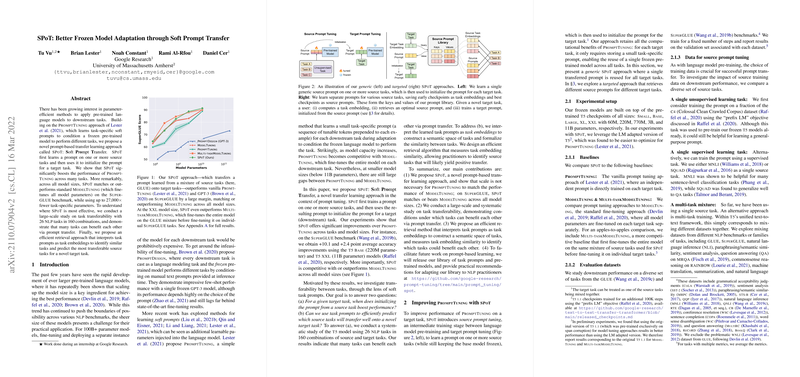Soft Prompt Transfer: Advancements in Frozen Model Adaptation
The paper "SPoT: Better Frozen Model Adaptation through Soft Prompt Transfer" introduces a sophisticated method for enhancing the efficacy of prompt-based learning in LLMs without full parameter tuning, titled Soft Prompt Transfer (SPoT). By leveraging a novel transfer learning strategy within the context of prompt tuning, this work achieves significant strides in closed-vocabulary NLP tasks.
Key Contributions
The authors present SPoT as an advancement over traditional PromptTuning. This involves training a soft prompt on one or more source tasks and transferring the learned parameters to a new target task—a process that notably improves the performance of frozen-LLMs across various tasks.
- Efficiency and Performance: SPoT is shown to be not only competitive but in many cases superior to ModelTuning despite involving significantly fewer parameters. On the SuperGLUE benchmark, SPoT achieves comparable or superior results to full model tuning, especially at the large model scale, with up to a 27,000× reduction in task-specific parameters.
- Study on Task Transferability: A comprehensive paper of task transferability across 26 NLP tasks reveals that many tasks can provide substantial benefit to each other via prompt transfer. This large-scale analysis involving 160 task combinations highlights that tasks, even seemingly unrelated ones, can mutually benefit from transfer learning.
- Prediction of Transferability: The introduction of an efficient retrieval method capitalizes on interpreting task prompts as task embeddings. By constructing a semantic space of tasks, this approach allows for the prediction of which tasks are most likely to confer benefits onto a novel target task—streamlining the selection process for source tasks in transfer settings.
Implications and Future Directions
The findings of this paper have significant implications both theoretically and practically. Theoretically, this work expands the horizons of prompt-based learning by endorsing parameter efficiency in adapting large pre-trained models, breaking the bind of conventional thoughts tied to complete model fine-tuning. Practically, the method demonstrates a considerable resource and computational advantage in deploying large models, making their application more feasible.
One anticipated future development is the application of similar transfer strategies in other adaptation methods that prioritize parameter efficiency, such as adapter tuning or prefix tuning, to further generalize and optimize model deployment. Additionally, refining task embeddings to better capture domain and task-specific nuances may lead to even more profound transferability insights. This work also sets the stage for exploring combinations of soft prompt parameters with sparse task-specific adaptations for more effective task generalization.
Conclusion
Through Soft Prompt Transfer, this paper not only narrows the gap between parameter-efficient tuning and comprehensive model tuning but also establishes a robust framework for predictive task transferability. The results indicate promising pathways for deploying large, frozen LLMs effectively across diverse NLP tasks, broadening the applications of deep learning innovations in resource-efficient computing environments.
